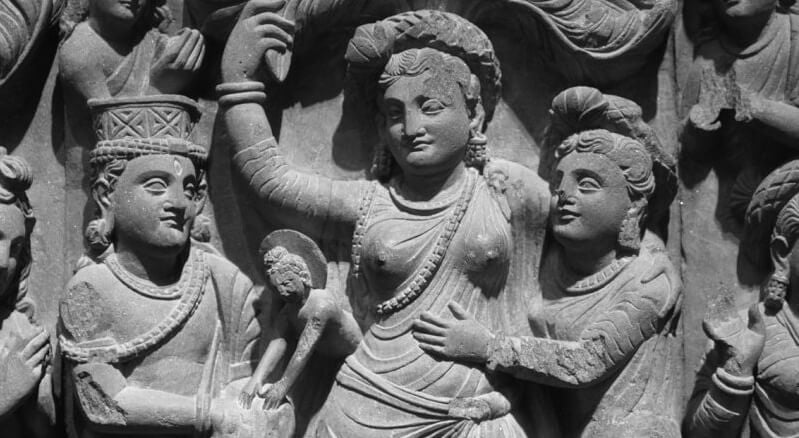Traveling and discovering is sometimes about being in the right place on the right day, for us that day was today, when India celebrates Ganesha Chaturthi.
This festival is also popularly called Vinayaka Cavithi or Vinayaka Chaturthi. It’s celebrated in honor of Lord Ganesha, the elephant-headed god, remover of obstacles, the god of beginnings and wisdom. Discover Mythology, rituals and history of Ganesh Chaturthi in India.
In this Article
The festival is observed in the Hindu month of Bhaadrapada, starting on the shukla chaturthi (fourth day of the waxing moon period). The date usually falls between 19 August and 20 September. The celebration lasts for about 10 days, ending on Anant Chaturdashi, the fourteenth day of the waxing moon period.
This day is celebrated to commemorate the birthday or the rebirth of Lord Ganesha who is the son of Goddess Parvati and Lord Shiva. Lord Ganesha is celebrated as the God of wealth, good fortune and harmony trough out India.
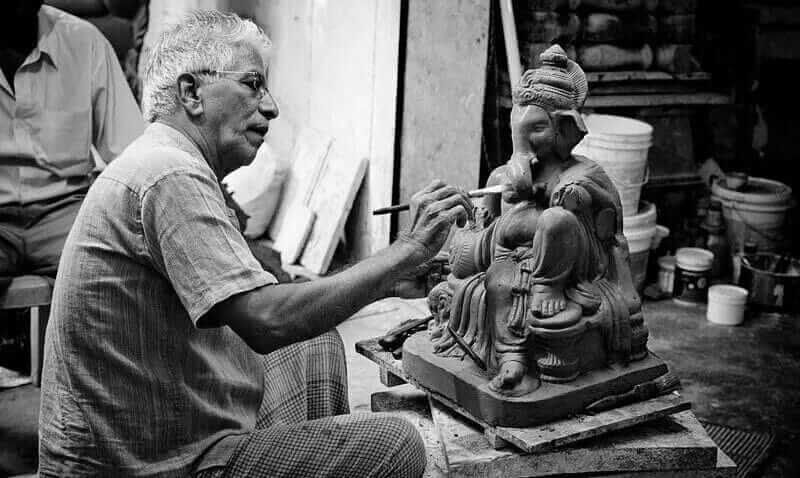
Ganesha Chaturthi involves installing clay images of Ganesha in public pandals or homes, which are worshiped for up to ten days and then immersed in a water body. It is believed that Ganesha bestows his presence on earth for all his devotees during this festival.
The festival is celebrated all over in India particularly in Maharashtra with blustering zeal and ecstasy. Months before the festival, preparations begin with lighting arrangements to illuminate the houses, skilled artisans create clay idols and artists erect awestruck pandals.
MYTHOLOGY: Ganesh Chaturthi or the rebirth of the elephant headed deity
Mythology of Ganesh Chaturthi from Brahma Vivartha Purana
The mythology behind Ganesh Chaturthi is contained in the Brahma Vivartha Purana, under the section of Ganesha Khanda. There are many variants of the stories which narrate the birth of the God of Supreme Self, Lord Ganesha.
Lord Ganesha – Ganapati
One of the stories narrates that once Goddess Parvathi had created a human figure out of sandalwood in order to guard her door as she bathed. Another story says that the human being was created by Parvati out of the dirt of her body while she bathed. Whatever might be the material used for creation, the human figure was created by the goddess and life was instilled in it.
The sole purpose of creating the human being was for guarding the deity’s door for the privacy required while bathing.
But at that moment, Lord Shiva came back home and was furious to have been denied entry by the guard. In a fist of fury, Shiva chopped off the guard’s head, only to realize later that what a blunder he had done by beheading a human creation of Parvati. Lord Shiva then instructed his ganas or attendants to bring him the head of the first living creature they could find.
The first living creature they could find was an elephant 🐘, whose head they chopped off and brought to Lord Shiva. The deity then replaced the chopped head and infused life into it. This elephant headed God was named Ganapati or Ganesha, which means the chief of ganas or attendants of Shiva. Ganesh Chaturthi is thus the celebration of the re-birth of Lord Ganesh.
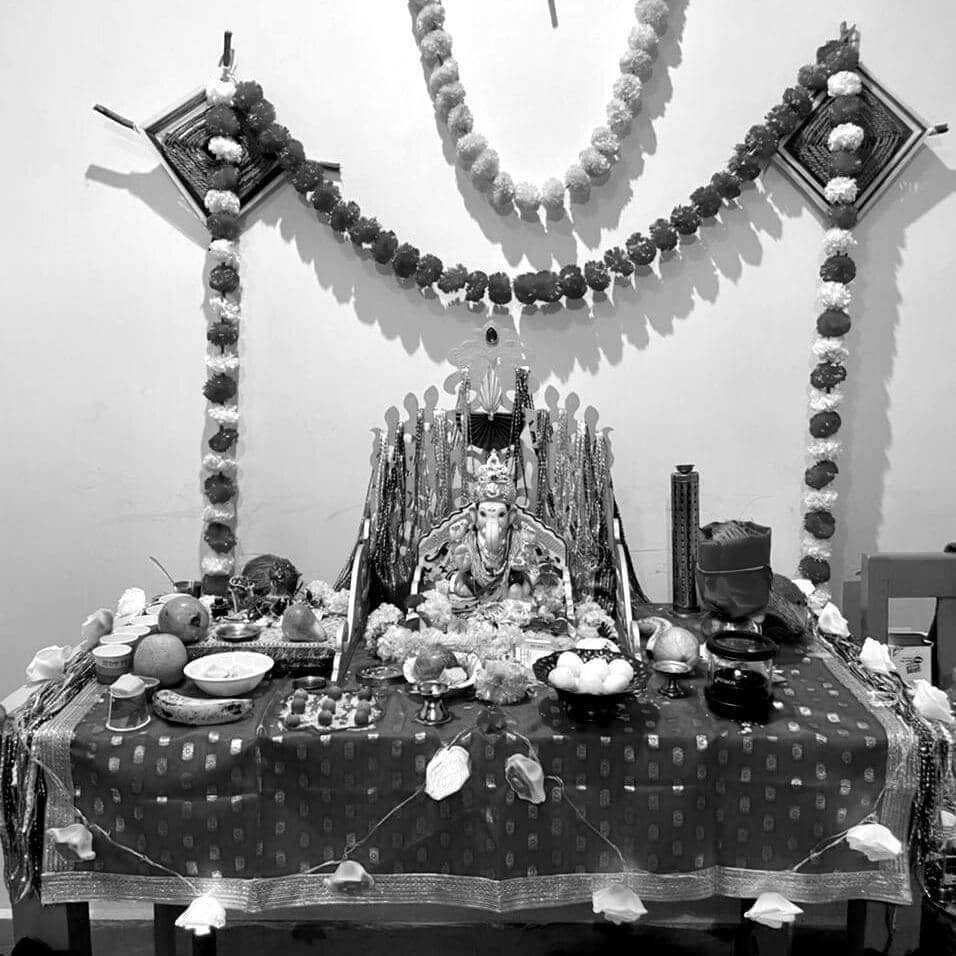
Ganesha – Vighnakartaa (the obstacle-averter)
Another story regarding the birth of Ganesha says that he was created by Shiva and Parvati on request of the Devas (gods), to be a vighnakartaa (obstacle-creator) in the path of rakshasas (demonic beings), and a vighnahartaa (obstacle-averter) to help the Devas.
Birth stories from Puranic literature
Ganesha – Gangeya (the son of Ganga)
Various birth stories of Ganesha are given in the Puranic literature. According to Matsya Purana and Padma Purana.
Parvati had a great desire for a son. One day she made a toy with an elephant-head from her bodily dirt. She immersed that toy in the Ganga where that small toy assumed an enormous size and life also. Both Parvati (Uma) and Jahnavi (Ganga) addressed him as son and hence he came to be renowned as Gangeya and Gajanana.
Ganesha – Shankaraputra (chief of his ganas – desires) and Vighnaraja (avoider of obstacles)
A very interesting birth story is described in the Varaha Purana.
It describes that Ganesha came into being only from the laughter of Shiva. He was very handsome at the time of his birth and due to this Parvati was gazing at him without a pause. Shiva became jealous to see that and out of jealousy he cursed Ganesha to be ugly with an elephant-head, a pot-belly and wearing a naga-yajnopavita (a snake worn as a yagnopavita or a string of pearls or gems).
But later on as remorse Shiva appointed him as the chief of his ganas and called him his son ‘Shankaraputra’. Shiva ordered that Ganesha should be worshiped before every work to avoid the obstacles and thus gave him the name ‘Vighnaraja’.
Ganesha is born with a trunk
The Vamana Purana gives a little different version of Ganesha’s birth.
Parvati made a toy from her bodily dirt. This was a four-armed, full-breasted male-being with the face of an elephant. After making him she put him under her throne and went for a bath. Then Shiva came and had a bath on the same throne under which was lying the filth made male being.
The sweat of Uma (Parvati) and Shiva mixed on the moist earth. From this union sprang up (a person) with a trunk, blowing air from it. Shiva was happy to recognize him as his son.
Ganesha – Vighneshvara (put impediments in the ways of wicked beings)
The Linga Purana describes that Shiva himself entered into the womb of Ambika (Parvati) and a handsome boy was born as Ganeshvara. Ambika welcomed the elephant-faced lord Gajanana. Shiva gave him the name Vighneshvara as he was born to put impediments in the ways of wicked beings, the asuras – demons.
Ganesha – Sadyojata (born in trice)
The Brahma Purana mentions that Ganesha, son of Ambika was born at the same moment he was conceived. Hence the gods called him ‘Sadyojata’ (born in trice).
The Skanda Purana gives three stories of Ganesha’s birth.
The gods were worried to see that the heaven was too full of the humans to accommodate any more. Being worried about this immigration, they requested Shiva to devise means to check this. After hearing the request of the gods, Shiva glanced at Parvati. She got the hint and began rubbing her body.
From her bodily dirt she made a four-armed human figure with an elephant-head. The newly born was instructed to put impediments in the ways of wicked beings and thus the gods were relieved from their grief.
Ganesha – Vinayaka (the obstacle-averter)
Oonce god Vayu told Shiva that they were worried as Shiva had no progeny who could protect them. On hearing this Parvati (Gauri) became angry and left Shiva and went to the mountain ‘Arbuda’ to practice penance. After some time Shiva also went there and told Gauri that she will have a son on the fourth day. She took her bath and removed the dirt from her body and created a human figure who was none else than Vinayaka.
Ganesha – Mahavinayaka (the great remover of obstacles)
Parvati made him from her bodily dirt just in a fun but the figure remained headless due to shortage of dirt. So Parvati ordered Skanda to bring the head of an elephant for that headless figure. Skanda brought an elephant-head but Parvati disliked it because the head was very large. Although Parvati was denying for this head but it got joined to the headless body by action of fate. Shiva gave him the name ‘Mahavinayaka’.
Ganesha – Krishna (one of god Vishnus forms)
The Brahmavaivartta Purana mentions that Ganesha was originally Krishna. As Parvati was desirous of a son, Shiva advised her for Vratas and severe penances. Parvati did and her desire was fulfilled. Krishna was born to her. Vishnu wished him to be as brave as Vishnu himself and blessed him all the siddhis (magical powers).
The Suprabhedagama gives a little different birth story. According to it Ganesha was born with an elephant-head when Shiva and Parvati assumed elephant forms. Shiva himself told Ganesha that he was born after Shiva and Parvati enjoyed themselves in the form of male and female elephants in the forests.
Mythology of Ganesh Chaturthi from Shiva Purana
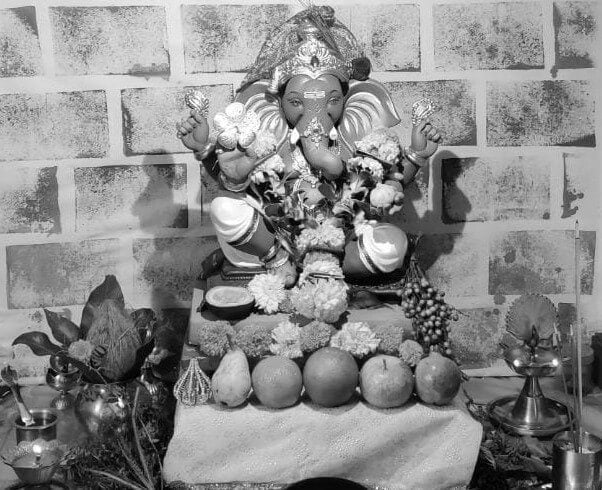
It is said that Ganesha was created from the dough which Goddess Parvati had created to take bath. Parvati wanted somebody to guard here when she takes bath and so, she created a doll from her dough and filled it with life so as it can stand at the door to guard. Later the doll was called as Ganesha and that day is celebrated as Ganesha Chaturthi.
On one fine day when Goddess Parvati was taking bath, Shiva came to meet her. Since Ganesha did not know him, he refused to give him entry into the house. Upon this, Shiva got angry and he beheaded Lord Ganesha out of rage. This made Parvati sad and Shiva promised her to bring back life into his body.
And, later when he went onto search for the head of a dead person, he could not find one. He could only find the head of a dying elephant baby and he therefore fitted it into the body of Ganesha to bring life into him. That gave rebirth to Lord Ganesha with the head of an elephant rather than a humans.
Variant: Ganesha – Vighnaharta (the power that takes away the obstacles)
Parvati made Ganesha with her bodily dirt on the advice of her companions Jaya and Vijaya. After making Ganesha she kept him as ‘dvarapala’ (door guard) at the gate of her private apartments. Even Shiva was not allowed by Ganesha to go inside.
As Shiva did not recognize him, he became angry at the misbehavior of Ganesha. On this matter a fight started between Shiva and Ganesha. Ganesha defeated Shiva’s army. This defeat aroused Shiva’s anger and he cut off Ganesha’s head.
When Parvati heard about this incident she was grieved and in anger she created hundreds and thousands of goddesses. These goddesses started destruction and created havoc. The fight was so severe that gods went to Parvati and begged her pardon.
But Parvati agreed only to stop it if her son would come to life and would get an honorable status among the gods as the chief presiding officer. Then Ganesha’s headless body was given a single-tusked elephant-head and he became alive.
After coming to life Ganesha was red-complexioned. Shiva recognized Ganesha as his son. Then Ganesha begged pardon and paid reverence to gods and also to his father Shiva. Shiva blessed him to be ever happy and also blessed him ‘Vighnaharta’.
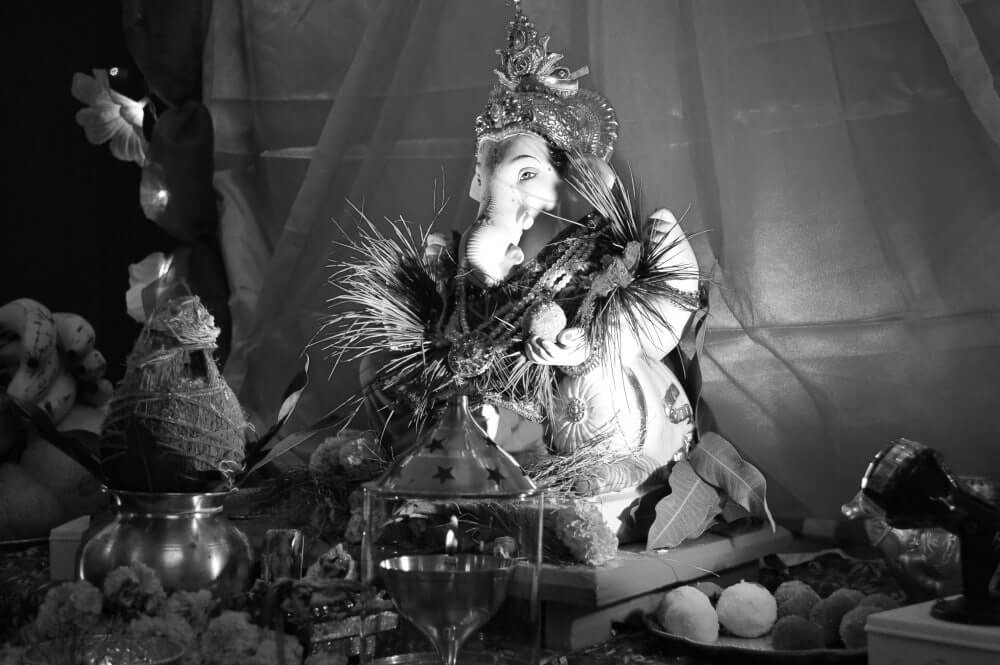
Rituals of Ganesha Chaturthi
We have been spontaneously invited to join the celebration by Urshita and Saurabh, a lovely couple from Maharashtra we met in Goa.
“On the first day of Ganesh Chaturthi, devotees take a ritual bath and wear new garments, before engaging themselves in the worship of the deity”, Urshita explains. So I need to wash the hands before touching the idol.
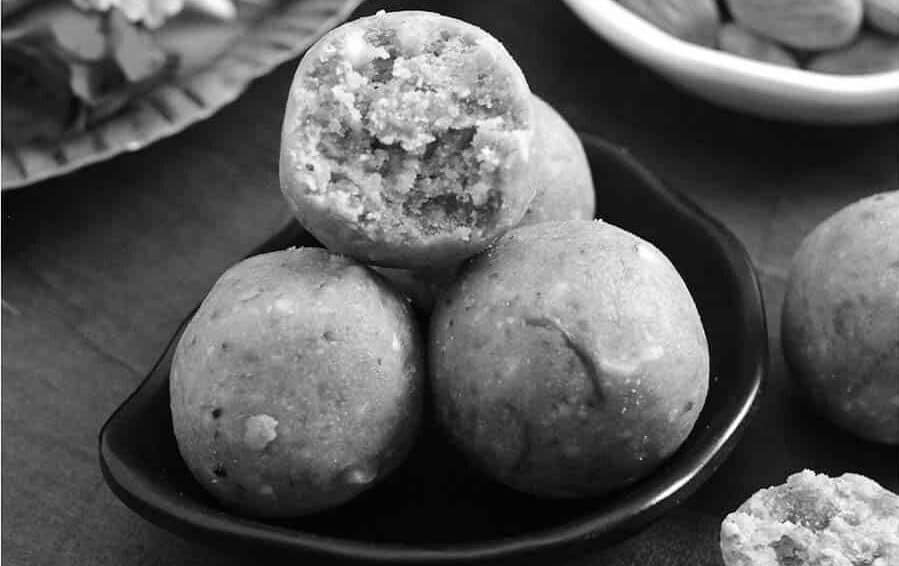
The Ganesh Chaturthi celebration at home begins with installing the clay idol of Ganesha. This ritual requires coconut, rice, betel leaf, betel nut, 21 blades of dhruva grass, incense sticks, sandalwood paste, and cotton wicks, sindur (traditional vermilion red or orange-red colored cosmetic powder worn by married women) and camphor. A number of dishes, like dahi (yogurt) milk, honey and sweet and salty snacks are offered to the lord. It is believed that offering food on a Banana leaf pleases Lord Ganesha.
It is a popular belief that during this time, Lord Ganesha visits the home of his devotees and brings good luck and fortune.
The idol is bathed in scented water (Abhishekam) and then adorned with flowers. “This you wont see often”, Urshita says unpacking several silver statues, its Durga, Sarasvati, Buddha, Krishna and a Shiva linga, they are ceremoniously washed, dried and adorned next to the Ganapati murti (idol). Mantras are sung for all gods.
Rituals of worship on Ganesh Chaturthi
The worship begins with the chanting of mantras to invoke life into the clay idol. After this, Shodashopachara or customs of offering prayer by sixteen ways follows:
- Aavaahana, or in other words, invite.
- Aasana means offering a seat to the guest.
- Paadya means to clean the feet of the idol.
- Arghya or in other words, washing the hands of the idol
- Aachamana is drinking only three gulps of water to enhance speech delivery.
- Madhuparka means offering a drink to the idol.
- Snaana means washing idol with ghee, milk and curd.
- Vastra or Upaveeta is giving new attires to the idol.
- Gandha isapplying sandalwood on the forehead of the lord.
- Pushpa or offering of flowers.
- Dhoopa is the fragrance from burning herbs.
- Deepa means admitting lord as divine light.
- Naivedya is offering varied dishes.
- Taamblooa is having betel leaf with herbs for good health.
- Aarati is an earthen lamp circulated around the deity. The fire ceremony is performed and 108 names of the lord is chanted along with slokas and mantras.
- Mantrapushpa is going around the deity and chanting mantras.
The core essence of these rituals is the same throughout India, with slight variations from place to place and household to household.
Food for Ganesh Chaturthi

Ganapati likes food, so its tradition to feed him well on his birthday. Modak is a popular food of this festival and is the main offering done, as it is considered to be one of the lord’s favorite sweet. Ukadiche Modak are steamed rice flour dumplings stuffed with fresh scrapped Coconut, Jaggery and Nuts. Other delicacies of this festival include:
- Jeev Kadgi Podi (Bread fruit fritters)
- Appam is a type of pancake, originating from South India, made with fermented rice batter and coconut milk.
- Pedha are made of coagulated milk solids. It forms the base for wide variety of Indian sweets like Gulab Jamun, Pedha, Barfi / Fudge and Rasgulla.
- Laddoo is a sweet ball made up of roasted Semolina and Coconut and combined with sugar syrup, ghee and dry fruits.
- Kheer and other rice dishes.
- Sundal is chickpeas and
- Karanji is a sweet deep-fried dumpling.
The Visarjan or immersion marks the end of the celebration of Ganesha Chaturthi
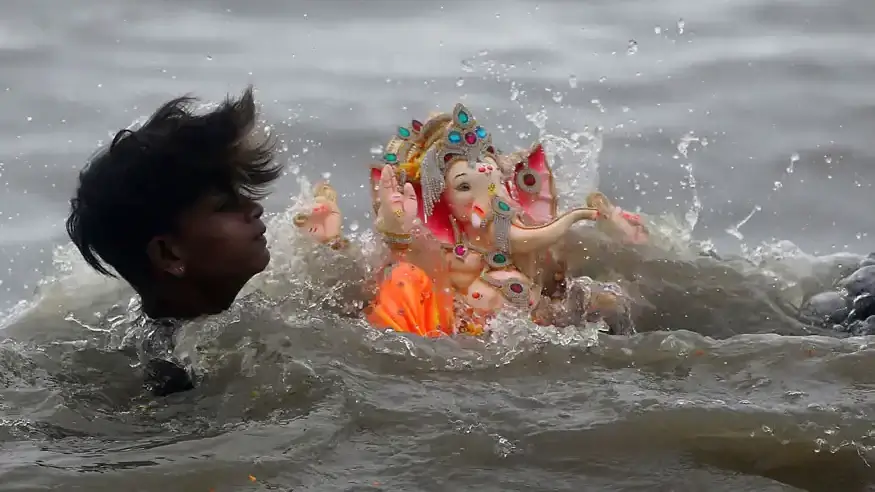
The ten day festival comes to an end with the immersion of the idol in water. It is believed that Lord Ganesh bids good bye to his devotees after immersion and takes away all their misfortunes with him. Ganesha, who is also known as the Lord of New Beginnings, is in this ritual worshiped as the Remover of Obstacles.
There is another interesting story about Ganesh visarjan. It is believed that Lord Ganesha returns to Mount Kailash to join his parents Lord Shiva and Goddess Parvati on the last day of the festival.
The celebration of Ganesh Chaturthi also denotes the significance of the cycle of birth, life and death.
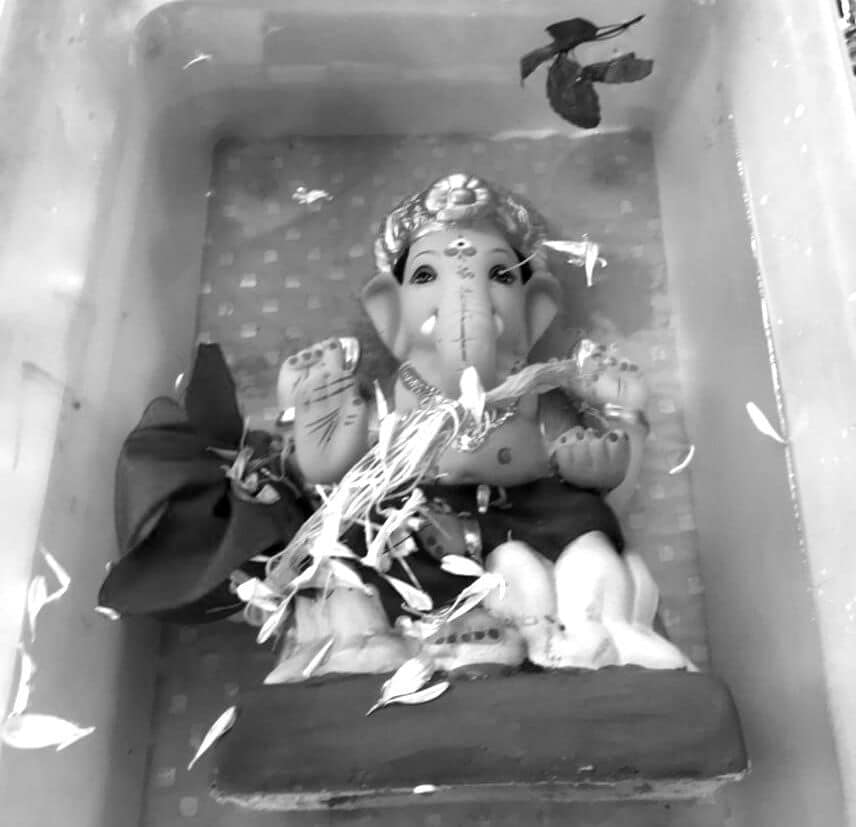
While it might seem like a good idea to skip the visarjan and keep hosting the God for fortune and prosperity, it is said that the power that suffuses the statue after 10 days of worship is all a human can bear. So it is not to be kept longer.
Urshita and Saurabh send us a picture of their Ganapati in a plastic pot with water, they did the visarjan in it and would bring the dissolved material to the see, what an eco friendly solution. Some statues are prepared as such that its constituent materials actually benefit the ecosystem they enter, it may break down to the clay from whence it came.
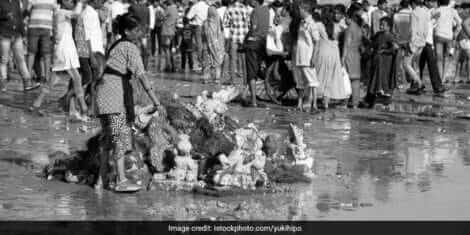
However in recent years the immersion of Ganesha idols made of non-biodegradable materials and the use of poisonous substances in the paints has led to pollution of water bodies and taken away from the positive symbolism and impact of the ritual.
While the idol is taken to the sea or a river in a procession with a lot of pompous and grandeur. During the Ganesha processions, proceeding the immersion, devotees chant
“Ganpati bappa morya, pudhchya warshi lavkar ya”,
it indicates that devotees are referring to Ganesha as the Lord of all (Ganpati) and a father (Bappa), who was worshiped by Morya Gosavi. They are praying to Him that He should return soon (lavkar) next (pudhcha) year (warshi).
“Ganpati bappa Morya, Mangalmurti morya!”
means that Ganpati gives serenity and one who makes things ‘auspicious’ or ‘pure’ (mangal). ‘Murti’ means an ‘idol’ or ‘form’. Ganpati is purity in its ultimate form.
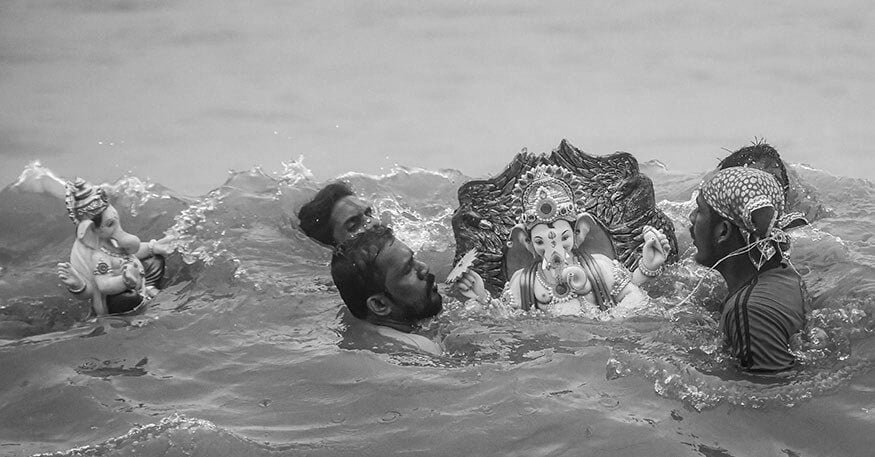
The legend of Bappa Morya Gosavi
There was a great devotee of Lord Ganesh in the 14th century named Morya Gosavi. He was originally from village called Shaligram in Karnataka where his devotion was looked upon as madness. He later travelled and settled in Chinchwad, near Pune and invoked the Lord with severe penance. Morya attained siddhi (special powers and blessings) at Shree Chintamani and his son built the temple to commemorate the event.
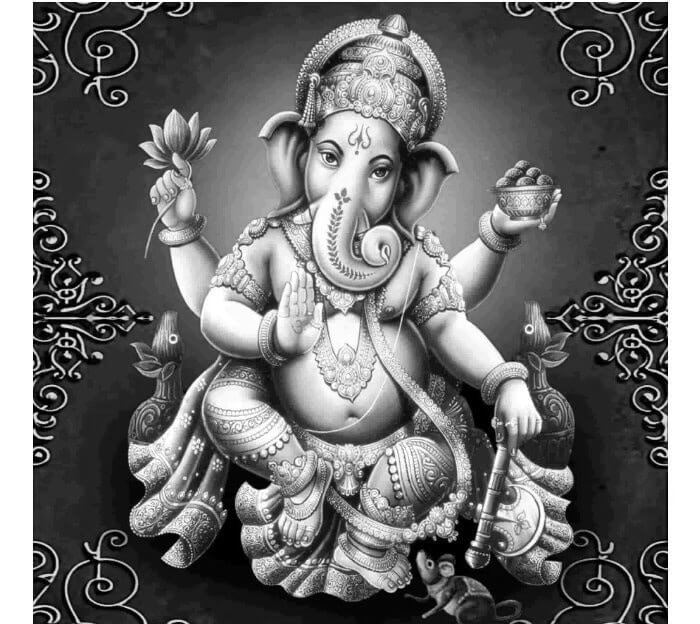
It is said that Morya also performed penances at Siddhivinayak in Ahmedabad and Moreshwar at Morgaon where he built a temple too. Tukaram Maharaj and others have endorsed Morya Gosavi as one who merged with Ganesha.
Lord Ganesha, happy with Morya’s devotion, appeared in his dreams and granted him a boon. Morya refused any material wealth and asked that his name be forever connected with the lord himself.
This can be said to indicate the inseparable bond between God and His devotee. So Lord Ganesha declared that every time His name is chanted, it should be followed by Morya. Thus the chant ‘Ganpati Bappa Morya!’
(loving father Shri Ganesh ji of Morya Gosavi).
However, according to another story, ‘Morya’ is said to be a combination of two words, ‘mhore’ and ‘ya’. In the Kolhapuri dialect ‘mhore’ and ‘ya’ collectively means ‘please come forward and bless.’
Jet one more explanation exist: Ganesha is also known as Ganpati. The word Ganpati is a combination of two words – “Gana” which means ‘group’ or also ‘the attendants of Lord Shiva’ and “Pati” which means the ‘ruler’ or ‘leader’. Hence “Ganpati” means “ruler of many” or ‘leader of the ganas of Shiva.’ ‘Bappa’ means ‘father’ or ‘the lord.’
Myth of God Anant (Vishnu)
Visarjan is also a day to worship God Anant for the devotees of Vishnu. Those who believe take part in special prayers and then tie a holy thread on their wrist, taking an oath to the God Anant. In return, the god blesses them with prosperity and fortune.
Once there was a girl named Sushila. Her father was a Brahmin named Sumant who remarried Karkash after Sushila’s mother passed away. Karkash was not as nice Sushila and so when Sushila got married she decided to move away with her husband. Her husband was called Kaundinya and on their journey from her home they came upon a river.
Kaundinya went for a bath and while he was bathing Sushila saw some women praying. She joined them and asked them about their worship. They explained that they were worshiping a god called “Anant”, and when Sushila questioned them some more, they explained the significance on Anant’s vow.
As she was starting a fresh life with her husband Sushila thought it best to pray with them and take the vow as Anant’s blessings would surely help her husband and her in their new life. The women taught her the rituals and she took the vow, tying the ceremonial thread on her left hand (As is traditional for women. Men tie it on their right).
It seemed that Anant had truly blessed them for Sushila and Kaundinya prospered in life. One day Kaundinya questioned her on the thread she wore and she told him of her vow and Anant’s blessing. He was not happy to hear she believed that and argued that all they had gained was due to his own hard work and intelligence. They both argued on this and took the Anant string from her hand and threw it in a fire.
After that several misfortune fell upon them and they were reduced to poverty. Finally, Kaundinya understood that their fortune was due to Anant and he underwent severe penance to find Anant and ask for forgiveness. When Anant revealed himself Kaundinya realized that Anant was just another name for God Vishnu, the Eternal one.

History of Ganesh Chaturthi
The festival was started by Chatrapati Shivaji Maharaj (1630–1680), a brave, warrior king and founder of the Marathi Empire. The Peshwas encouraged the worship and celebration of Ganesh Chaturthi in their state capital Pune, as Ganesha was their family god. With the fall of the Peshwas, this festival lost the state patronage and became a homely celebration.
Finally this celebration was revived as a state affair by the freedom fighter Lokmanya Tilak who used it as a tool to spread the message of freedom and gain public support during the national movement for freedom in India.
During the Peshwa Empire the festival was celebrated only by the upper class but Lokmanya Tilak popularized it as a festival of the masses and people of all strata of the society joined in.
The festivities involved theatrical performances, dance dramas, debates, musical concerts and poetry recitals where Indians from all class and caste participated and this was the incipient stage of developing unity among the Indians so that they could jointly put up a tough struggle against the supremacy of the British.

From then onward, Ganesh Chaturthi is celebrated not only in Maharashtra but nationwide with splendor and grandeur. Ganesh Chaturthi was declared a nationwide festival after India gained independence in 1947.
God Ganesh
Ganesha has the head of an elephant and the body of a human. He is one of the best-known and most popularly worshiped deities in Hinduism. Ganapati is worshiped by both Vaishnavas (devotees of Vishnu) and Saivites (devotees of Shiva).
The son of Shiva and Parvati, Shree Ganesha, is the God of good luck and auspiciousness and is the Dispeller of problems and obstacles. He is also worshiped as the God of wisdom, wealth, health, celibacy, fertility and happiness. People call upon him at the beginning of any task, because his blessing supposedly ensures success.

Ganeshas elephant head symbolizes immense wisdom which is brought about by “manana” or independent thinking or reflection. In turn “manana” is brought about by the process of “shravana” or intake of spiritual knowledge which is depicted by the deity’s huge ears. The well-developed trunk of the lord depicts wisdom and symbolizes intellect of a perfectionist. Lord Ganesha is believed to ride on a mouse which signifies trouncing the ego.
The food served at the lord’s feet symbolizes material wealth and power. He is holding a rope signifying spiritual knowledge, an axe that symbolizes annihilation of desire, modak or laddoos (are the preferred sweets) and stand for happiness and the lotus for the divine state of self-realization.
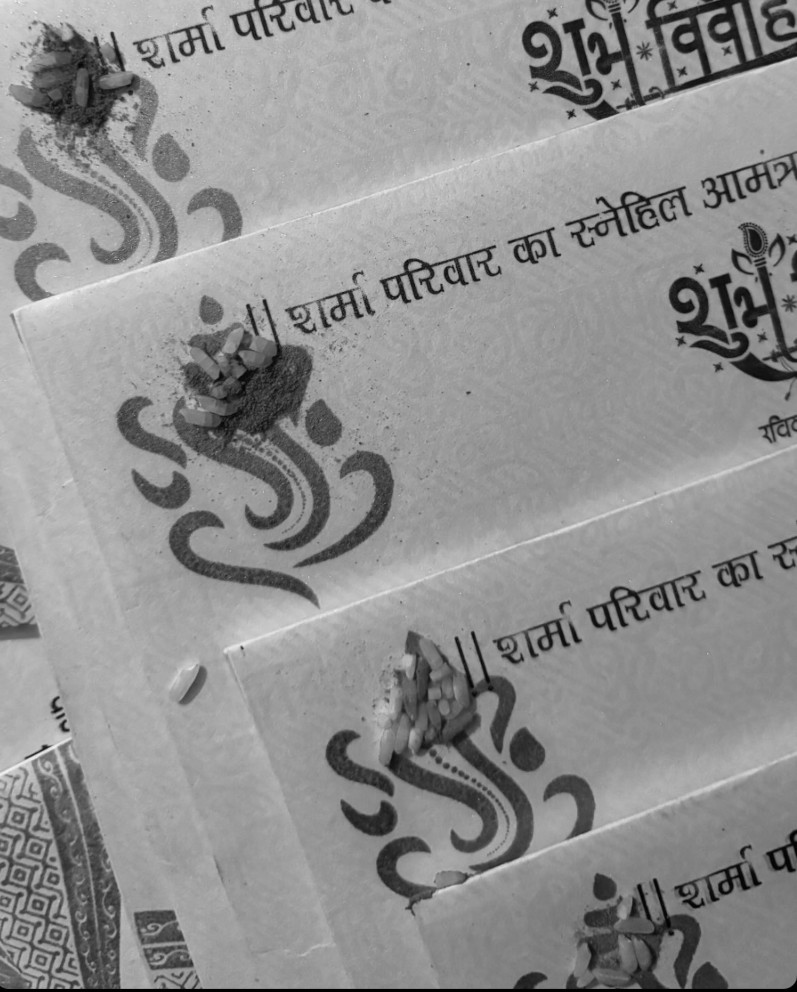
Lord Ganesha is both the ‘Vighnaharta’ (vanquisher of impediments) and ‘Vighnakarta’ (master of obstacles).
Just as he helps his devotees by removing the obstacles from their lives, he is also the one who creates hurdles in the lives of evil men.
Popularly known to be the God of prosperity and fortune, Lord Ganesha’s image is printed on invitation cards for wedding ceremonies.
Ganesha idols are stationed at the entrance of houses to allow positive vibrations to enter the house and bring good luck to the inhabitants.
ॐ
The idol often has an Om ॐ painted on his forehead.
Om is a holy symbol that represents Brahman – the omnipresent, omnipotent and the source of all existence. It has more than 100 meanings from which one of the words means, ‘welcoming the gods’. In Ganesh Purana, Lord Ganesha is also addressed by the names Pranava and Om. It is said that Om was the first sound produced from where the universe arose.
This one syllable symbolizes the whole creation and the entire cycle that runs from creation to destruction. Hence, before commencing any auspicious occasion, Om is uttered and before worshiping any god or goddess, prayers to Lord Ganesha are offered.
BELIEVE: One should not look into the Sky at the Moon on Ganesha Chaturthi Day!
Ganesh Chaturthi is observed for prosperity and good fortune as long as you do not look at the moon.
People believe that looking into the sky at the Moon on the day of Ganesha Chaturthi will cause a person to suffer from false charges. And, this curse, after looking at the moon, can only be fought with by listening to the story of Syamantaka Jewel that will also remove all your troubles. If you are intentionally looking at the moon then the person cannot refrain from facing the curse. There isn’t any remedy in that case.
It is said that on one of his birthdays, Lord Ganesha was moving from one house to the other getting sweets. With whole of the process, he ate a great many of Ladoos and sat on his rider mouse. The mouse upon seeing a snake stumbled and got frightened. As a result Ganesha fell down and all the Ladoos fell from his mouth. Nevertheless, Ganesha stuffed back all the Ladoos and tied his stomach with the snake.
It was the Moon who saw all this and began laughing out loud! He got angry after that and out of anger Lord Ganesha pulled out one of his tusks and threw it onto the moon. Ganesha cursed him that, it will be considered inauspicious to look at him on the day of Ganesha Chaturthi. And that is the reason people do not look at the moon on the day of Ganesha Chaturthi.
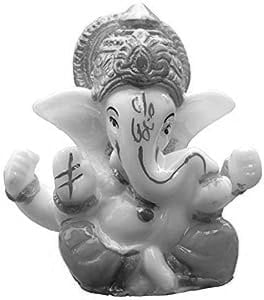
Variant from Skanda Purana
It is said that once when Lord Ganesha was invited to Chandralok for a feast. At that time, he ate a huge number of Ladoos and so he was not able to walk and balance himself. He was so full that, all his stomach busted and all the Ladoos came out.
Upon this, moon started laughing at the sight that made Lord Ganesha angry and cursed Moon that it is going to be destroyed. After, this curse moon disappeared from the Universe and the whole world started to live in darkness. The universe gradually stared becoming wane for the lack of the moon light.
All the Gods prayed to Lord Shiva to change Lord Ganesha mind and take his curse back. The Moon also showed his apologies to Ganesha for whatever he did.
Upon, all this Lord Ganesha agreed to take back his curse but he said that moon will be invisible on one day of every month and would be only partially seen on the day of Ganesha Chaturthi. He also said that those who will be watching the moon on the day of Ganesha Chaturthi will have to face a false accusation.
And, that is the reason that people avoid looking at the moon on the day of Ganesha Chaturthi.
“Ganpati bappa morya, pudhchya warshi lavkar ya”,
which means pleading the deity for good luck and fortune to return to visit the next year.
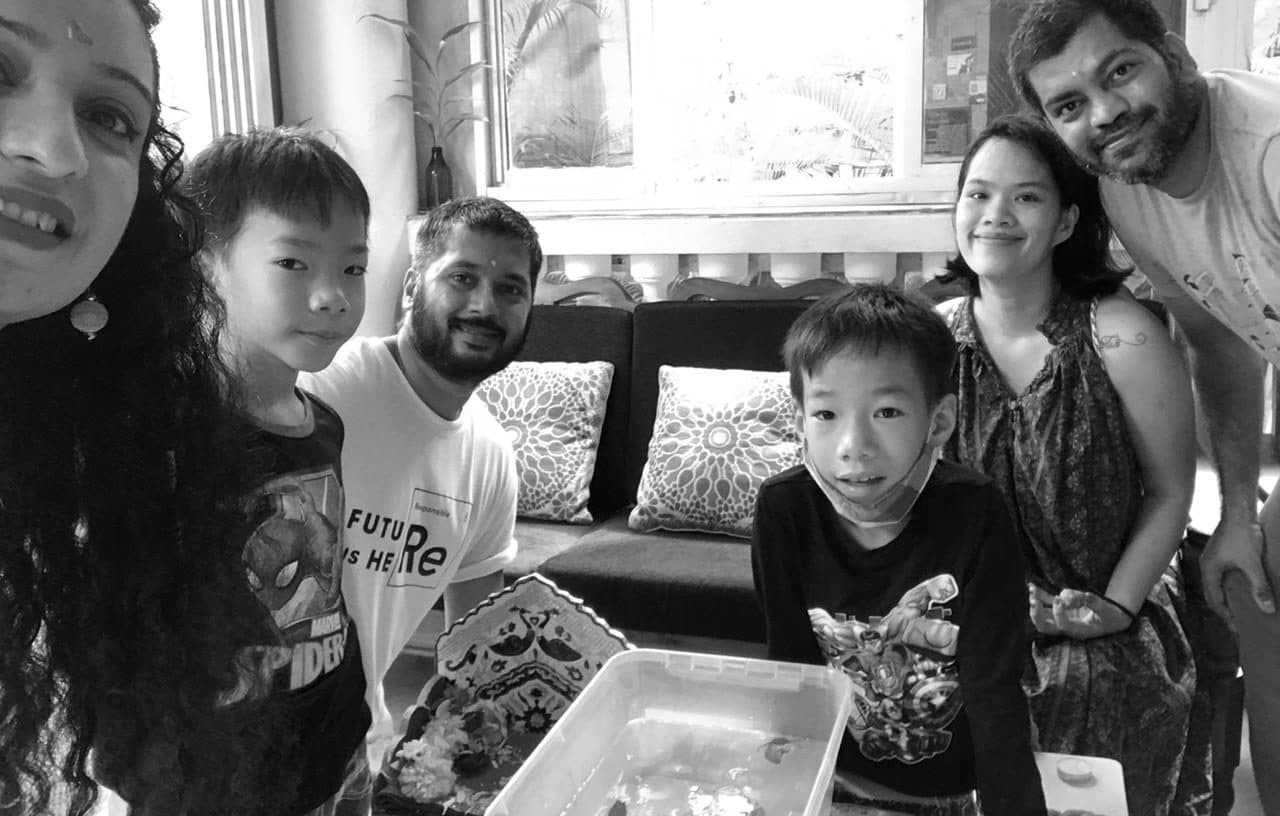
Enjoy the following folktale for Ganesh Chaturthi:
Ganesh with a Fist-full of Rice and a Spoon-full of Milk
A long time ago, in a village in India the villagers were preparing for Ganesh’s birthday on the occasion of Ganesh Chaturthi. The houses were being cleaned and decorated with fresh flowers and garlands. The men were busy buying different things required for worship from the market so that the women could cook. The women were busy cooking sweets and Modak (a sweet Ganesh is fond off) for offering to Ganesh when they worshiped him.
The children were also busy wearing new clothes and running around getting in everybody’s way in anticipation of the celebrations. The adults were indeed very very busy giving a festive air to their houses and the entire village. There was so much to do.
A young boy in rags and torn clothes walked into this busy village. He looked around him and was happy to see so much activity. He saw children running around in all their fine clothes. The village children had no time for him as he looked very poor.
The boy stopped a young girl and asked her:
“Excuse me, I am very hungry. I have a fistful of rice and about a spoon full of milk. I need somebody to cook it for me. Can you help me?”
The girl was taken aback and answered:
“Are you mad? Who can cook anything with so little rice and milk? Go away I have no time for you. Can’t you see we are all busy preparing for Lord Ganapati’s birthday celebration.”
The boy felt very sad and went to the first house on his left. He saw a lady dressed in a pretty silk saree at the door. She was cleaning the courtyard of her house. He went up to her and said very humbly:
“Excuse me Mausi (mother’s sister), I am very hungry. I have a fistful of rice and about a spoonful of milk. I need somebody to cook it for me. Can you please help me? I will be very grateful.”
The woman was shocked that this boy in rags had the audacity to ask her to do something for him. She got angry and yelled at him:
“How dare you talk to me? You dirty, filthy boy, you need a bath. We have puja in our house. Do not come in and touch anything as it will become impure. I have enough to do in my house to welcome Ganapati today. Go away and don’t come to my door again.”
The little boy went away looking even more depressed.
He went from one house to another showing his fistful of rice and about a spoon full of milk requesting whomsoever he saw:
“Kaka (uncle), Dada (grandfather), Dadi (grandmother), Bhaiya (brother), Chachi ( aunty), I have a fistful of rice and about a spoon full of milk. I need somebody to cook it for me. Can you please help me?”
He felt that maybe there was at least one kind person in the entire village that would help him. Every one sent him away, some in anger and some in disgust.
As he walked, he saw a priest near the temple and thought to himself that finally here is a man who is in the service of God. He spends his time praying, teaching and giving sermons to the people. He will surely feel compassion for me. I will approach him and ask for help.
The priest had had his morning bath, performed his prayers and finished the morning rituals of the temple. He was happy as it was Ganesh Chaturthi and a lot of people would come to the temple to offer prayers, gifts and money. He was thinking how much money would come in by the evening when he saw a small boy in dirty rags standing and watching him.
The priest thought he was a Brahmin and the little boy looked from a lower caste. The boy had no right to be at the temple gate and he was about to drive him away when the boy spoke up:
“Panditji namaskar, I am a poor boy and have just come to this village. I am very hungry. I have a fistful of rice and about a spoon full of milk. I need somebody to cook it for me. Can you tell me if somebody in this village can cook it for me?”
The priest was now livid. He felt the boy had no right to address him. He started shouting in anger and told the little boy:
“Run away. How dare you come to the temple and talk to me. There is no place for the likes of you. This is a temple. If you are looking for alms there is none for you here. Do not attempt to sully the Lord’s house.”
So saying, the priest locked the temple and walked away.
The little boy was very dejected and thought to himself:
“What has happened to the people here? They are so busy preparing for Ganesh’s birthday that they cannot feed one hungry little boy. They are so rude and insensitive.”
He started walking out of the village and as he walked towards the forest he saw a dilapidated hut. In the hut was a sick frail woman who was sleeping. He decided to try his luck one more time. He woke her up and said:
“Amma (mother), I am very hungry. I have a fistful of rice and about a spoon full of milk. I need somebody to cook it for me. Can you help me?”
The women blinked her eyes and shook off her sleep. She was very tired but on seeing the little boy and hearing his request she was amused. She said:
“Son, how can I cook just a fistful of rice and a spoon full of milk and turn it into kheer (pudding)? When I put it on the fire it will get burnt. Besides I do not have a pot to cook it in.”
She was humoring him but the boy said:
“Amma, borrow a pot from somebody and while you are doing so borrow a big one”
The woman was impressed by the boy so she decided to cook the rice and milk for him. She borrowed a big cooking pot; put it on fire with the ingredients in it. The boy said:
“Amma, I will go down to the river to have a bath till you finish cooking. We will both eat when I come back.”
So saying he went off to have a bath. The lady waiting for the fire to build so the cooking could start lay down on the floor. As she was not well and week with fever she soon fell asleep.
Suddenly she awoke up to the most appetizing smell of the cooking Kheer. She got up to see how just a fistful of rice and about a spoon full of milk could produce the aroma rising from the pot. She was stunned to see the pot was full to the brim with a sweet thick, creamy Kheer.
Her mouth started watering and she wanted to eat, but realized that she should wait for the little boy before eating. After all the kheer was before her because of him, so she waited. He was a long time in coming and she could not control herself. She served the kheer in a bowl and offered some to the Ganesh statue in her house. Then she sat down to eat.
The kheer was delicious and the lady took a lot of helpings till her stomach was very full. The boy came back from his bath and sat down. The lady served him the kheer. The boy asked:
“Amma, where is your bowl? We were to eat together.”
She was embarrassed and said:
“I am sorry but could not control myself and ate without you. Now I am too full to give you company.”
The boy said: “Amma, even I am full, I cannot eat any more”
The lady was getting very suspicious and asked:
“How is it that your stomach is full without eating? Who are you? The pot is full of kheer with only a fistful of rice and a spoon full of milk. I ate more than four bowls of the kheer as I was very hungry and still the pot is full to the brim.”
The little boy smiled and said:
“Amma, I am Ganesh” and transformed to his original form.
“Before eating you offered me the kheer, do you remember? I ate to my satisfaction then. The whole village is in preparation to welcome me and when I walked in nobody had time for me including the priest. In spite of being ill and poor you welcomed me. Amma ask me for a boon.”
The lady was very happy to have been of service to Ganesh and asked for health, wealth and prosperity. Ganesh granted her the wishes and disappeared. The whole village was shocked to learn that the poor lady living on the outskirts of the village in a shack was now overnight living in a big house and had everything the heart could desire.
~ ○ ~
Keep exploring:
Works Cited & Multimedia Sources
- https://www.chinmayaupahar.in/blog/why-we-chant-ganpati-bappa-morya/
- Sumana Dutta. A Monograph on the Elephant-Headed God Ganesha: The Mythological Concept and Distinct Iconography Senior Research Fellow- UGC, Department of Museology, University of Calcutta, Kolkata, West Bengal, India.
- https://ganesa.in/ganesh-chaturthi/
- Kapoor Dr Surendra.Ganesh Chaturthi – Significance and Rituals. https://timesofindia.indiatimes.com/religion/rituals-puja/ganesh-chaturthi-significance-and-rituals/articleshow/68206097.cms
- https://www.ganeshchaturthi.org/
- https://www.news18.com/news/india/ananth-chaturdashi-importance-and-story-behind-ganesh-visarjan-2305777.html
- More videos on our channel ROADSTORIEZ

